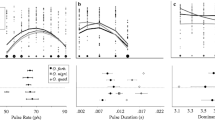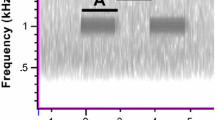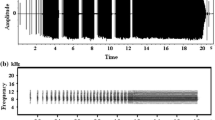Two closely related wood-cricket species, Gryllus fultoni (Orthoptera: Gryllidae) and G. vernalis, produce similar calling songs, consisting of 3-pulse chirps. Analysis of field and laboratory recordings of calling songs showed that, after correction to a common temperature, there was a divergence in chirp and pulse rates between far allopatric populations of G. fultoni and populations sympatric with G. vernalis. To determine whether the divergence in calling songs potentially provides reproductive isolation between G. fultoni and G. vernalis throughout the temperature range over which these insects sing, we recorded calling songs of lab-reared G. fultoni and G. vernalis populations between 18 and 28°C. Mean chirp rate significantly differed between sympatric and far allopatric G. fultoni populations as well as between sympatric G. fultoni and G. vernalis populations. Although there was a significant difference in mean pulse rate between sympatric G. fultoni and G. vernalis populations, pulse rate did not differ between sympatric and far allopatric G. fultoni populations in the laboratory study. Considering the magnitudes of differences in calling song characters discriminated by females of G. fultoni and the mean differences and the variability in calling song characters between the two species, the joint difference in chirp and pulse rates may be adequate for species discrimination over most of the range at which these crickets breed.




Similar content being viewed by others
REFERENCES
Alatalo, R. V., Gustafsson, L., and Lundberg, A. (1994). Male coloration and species recognition in sympatric flycatchers. Proc. R. Soc. Lond. B. 256: 113–118.
Alexander, R. D. (1957). The taxonomy of the field crickets of the eastern United States (Orthoptera: Gryllidae: Acheta). Ann. Entomol. Soc. Am. 50: 584–602.
Alexander, R. D. (1968). Life cycle origins, speciation, and related phenomena in crickets. Q. Rev. Biol. 43: 1–41.
Benedix, J. H. Jr, and Howard, D. J. (1991). Calling song displacement in a zone of overlap and hybridization. Evolution 45: 1751–1759.
Bennet-Clark, H. C. (1989). Songs and the physics of sound production. In Huber, F., Moore, T. E., and Loher, W. (eds.), Cricket Behavior and Neurobiology, Cornell Univ. Press, Ithaca, New York, pp. 227–261.
Blair, W. F. (1955). Mating call and stage of speciation in the Microhyla oliveacea-M. carolinensis complex. Evolution 9: 469–480.
Brown, W. L., and Wilson, E. O. (1956). Character displacement. Syst. Zool. 5: 49–64.
Carlson, A. D., Copeland, J., Raderman, R., and Bulloch, A. G. M. (1976). Role of interflash intervals in a firefly courtship (Photinus macdermotti). Anim. Behav. 24: 786–792.
Coyne, J. A., and Orr, H. A. (1989). Patterns of speciation in Drosophila. Evolution 43: 362–381.
Coyne, J. A., and Orr, H. A. (1997). ``Patterns of speciation in Drosophila" Revisited. Evolution 51: 295–303.
Dobzhansky, T. (1940). Speciation as a stage in evolutionary divergence. Am. Nat. 74: 312–321.
Doherty, J. A. (1985). Temperature coupling and ``trade-off" phenomena in the acoustic communication system of the cricket, Gryllus bimaculatus De Geer (Gryllidae). J. Exp. Biol. 114: 17–35.
Gerhardt, H. C. (1978). Temperature coupling in the vocal communication system of the gray tree frog. Hyla versicolor. Science 199: 992–994.
Gerhardt, H. C., and Huber, F. (2002). Acoustic Communication in Insects and Anurans. Univ. of Chicago Press, Chicago.
Grant, P. R. (1972). Convergent and divergent character displacement. Biol. J. Linn. Soc. 4: 39–68.
Hedrick, A. V., Perez, D., Lichti, N., and Yew, J. (2002). Temperature preferences of male field crickets (Gryllus integer) alter their mating calls. J. Comp. Physiol. A. 188: 799–805.
Höbel, G., and Gerhardt, H. C. (2003). Reproductive character displacement in the acoustic communication system of green tree frogs (Hyla cinerea). Evolution 57: 894–904.
Howard, D. S. (1993). Reinforcement: Origin, dynamics, and fate of an evolutionary hypothesis. In Harrison, R. F. (ed.), Hybrid Zones and the Evolutionary Process, Oxford Univ. Press. Oxford, pp. 46–69.
Jang, Y., and Gerhardt, H. C. (2006a). Divergence in the calling songs between sympatric and allopatric populations of a wood cricket Gryllus fultoni (Orthoptera: Gryllidae). J. Evol. Biol. 19: 459–472.
Jang, Y., and Gerhardt, H. C. (2006b). Divergence in female calling song discrimination between sympatric and allopatric populations of the southern wood cricket Gryllus fultoni (Orthoptera: Gryllidae). Behav. Ecol. Sciobiol. 60: 150–158.
Jang, Y., Bockhorst, A., and Gerhardt, H. C. (2007). Reproductive isolation in the wood cricket Gryllus vernalis (Orthoptera: Gryllidae). Ethology in press.
Josephson, R. K. (1984). Contraction dynamics of flight and stridulatory muscles of tettigoniid insect. J. Exp. Biol. 108: 77–96.
Loftus-Hills, J. J., and Littlejohn, M. J. (1992). Reinforcement and reproductive character displacement in Gastrophryne carolinensis and Gastrophryne olivacea (Anura: Microhylidae): A reexamination. Evolution 46: 896–906.
Marshall, D. C., and Cooley, J. R. (2000). Reproductive character displacement and speciation in periodical cicadas, with description of a new species, 13-year Magicicada neotredecim. Evolution 54: 1313–1325.
Martin, S. D., Gray, D. A., and Cade, W. H. (2000). Fine-scale temperature effects on cricket calling song. Can. J. Zool. 78: 706–712.
Noor, M. A. F. (1999). Reinforcement and other consequences of sympatry. Heredity 83: 503–508.
Olvido, A. E., and Mousseau, T. A. (1995). Effect of rearing environment on calling-song plasticity in striped ground cricket. Evolution 49: 1271–1277.
Pires, A., and Hoy, R. R. (1992a). Temperature coupling in cricket acoustic communication. I. Field and laboratory studies of temperature effects on calling song production and recognition in Gryllus firmus. J. Comp. Physiol. A. 171: 69–78.
Pires, A., and Hoy, R. R. (1992b). Temperature coupling in cricket acoustic communication. II. Localization of temperature effects on song production and recognition networks in Gryllus firmus. J. Comp. Physiol. A. 171: 79–92.
Ritchie, M. G., Saarikettu, M., Livingstone, S., and Hoikkala, A. (2001). Characterization of female preference functions for Drosophila montana courtship song and a test of the temperature coupling hypothesis. Evolution 55: 721–727.
Sanborn, A. F. (2001). Timbal muscle physiology in the endothermic cicada Tibicen winnemanna (Homoptera: Cicadidae). Comp. Biochem. Physiol. A. 130: 9–19.
Sawamura, K. (2002). Biology of reproductive isolation in Drosophila: Toward a better understanding of speciation. Popul. Ecol. 44: 209–219.
Schneider, H. (1977). Acoustic behavior and physiology of vocalization in the European tree frog, Hyla arborea (L.). In Taylor, D. H., and Guttman, S. I. (eds.), The reproductive biology of amphibians, Plenum Press, New York, pp. 295–336.
Servedio, M. R., and Noor, M. A. F. (2003). The role of reinforcement in speciation: Theory and data. Annu. Rev. Ecol. Syst. 34: 339–364.
Shimizu, I., and Barth, F. G. (1996). The effect of temperature on the temporal structure of the vibratory courtship signals of a spider (Cupiennius salei Keys.). J. Comp. Physiol. A 179: 363–370.
SPSS (2001). SPSS ® 11.0 Syntax Reference Guide. SPSS Inc, Chicago.
Toms, R. B., Ferguson, J. W. H., and Becker, S. (1993). Relationship between body temperature and air temperature in stridulating male crickets, Gryllus bimaculatus (Orthoptera: Gryllidae). S. Afr. J. Zool. 28: 71–73.
Tynkkynen, K., Rantala, M. J., and Suhonen, J. (2004). Interspecific aggression and character displacement in the damselfly Calopteryx splendens. J. Evol. Biol. 17: 759–767.
Veech, J. A., Benedix, J. H. Jr., and Howard, D. J. (1996). Lack of calling song displacement between two closely related ground crickets. Evolution 50: 1982–1989.
Walker, T. J. (1957). Specificity in the response of female tree crickets (Orthoptera, Gryllidae, Oecanthidae) to calling songs of the males. Ann. Entomol. Soc. Am. 50: 626–636.
Walker, T. J. (1962). Factors responsible for intraspecific variation in the calling songs of crickets. Evolution 16: 407–428.
Walker, T. J. (2000). Pulse rates in the songs of trilling field crickets (Orthoptera: Gryllidae: Gryllus). Ann. Entomol. Soc. Am. 93: 565–572.
ACKNOWLEDGMENTS
We appreciate the constructive comments of T. W. Kim, M. J. Littlejohn, and V. Marshall on this paper. We also thank A. Bockhorst for laboratory assistance. This work was supported financially by the University of Missouri Life Sciences Mission Enhancement Postdoctoral Fellowship to YJ and by a U.S. National Science Foundation grant (IBN0091993) and a U.S. National Institute of Health grant (NIH R01 DC05760) to HCG. The experiments in this study comply with the current law of the United States.
Author information
Authors and Affiliations
Corresponding author
Rights and permissions
About this article
Cite this article
Jang, Y., Gerhardt, H.C. Temperature Effects on the Temporal Properties of Calling Songs in the Crickets Gryllus fultoni and G. vernalis: Implications for Reproductive Isolation in Sympatric Populations. J Insect Behav 20, 33–52 (2007). https://doi.org/10.1007/s10905-006-9061-0
Published:
Issue Date:
DOI: https://doi.org/10.1007/s10905-006-9061-0




